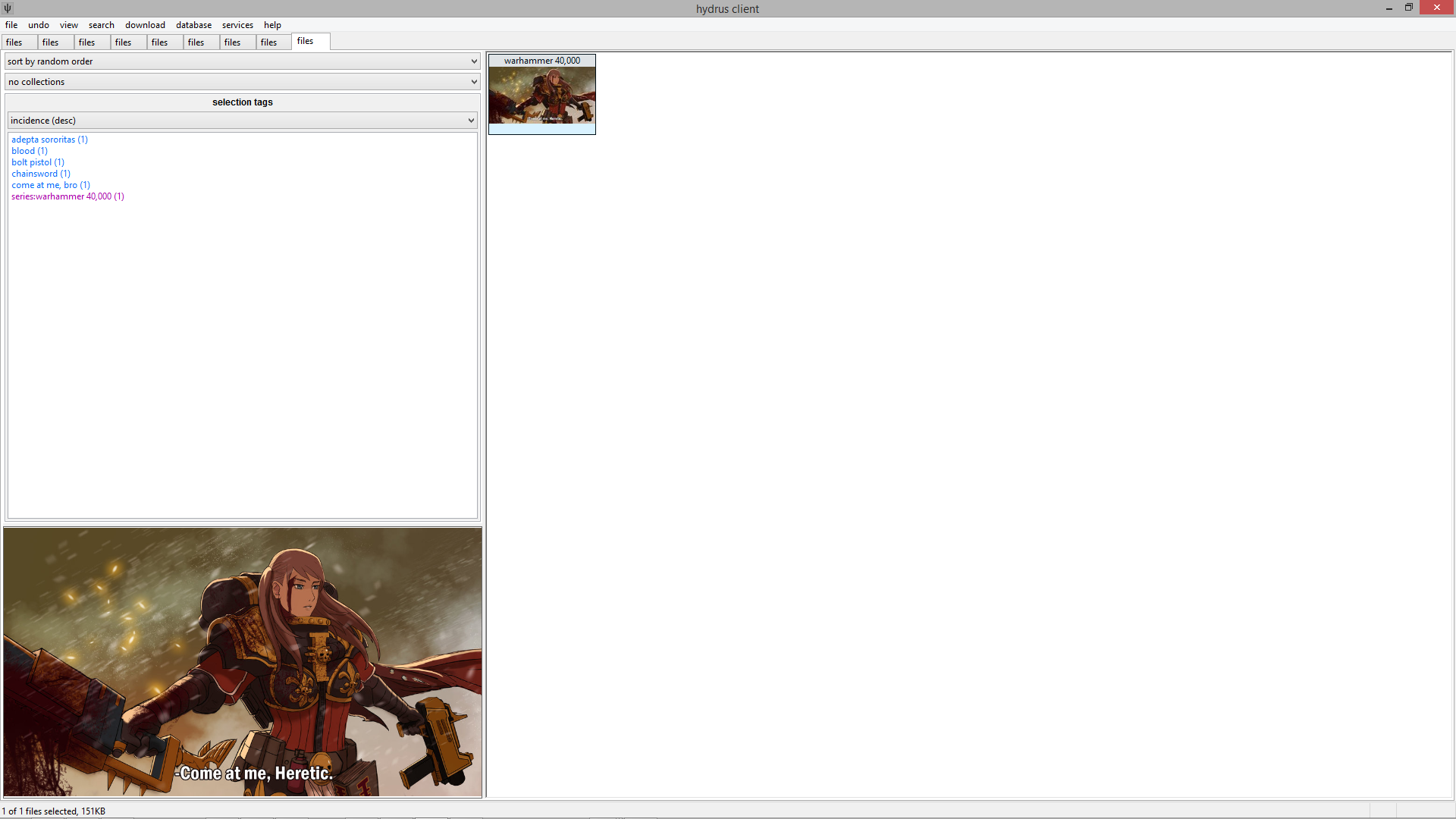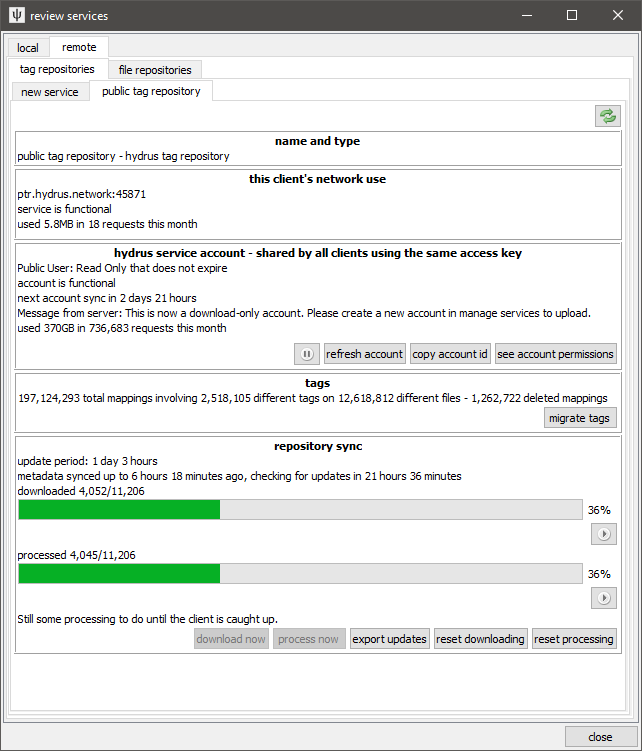7.5 KiB
| title |
|---|
| Tags |
Getting started with tags
A tag is a small bit of text describing a single property of something. They make searching easy. Good examples are "flower" or "nicolas cage" or "the sopranos" or "2003". By combining several tags together ( e.g. [ 'tiger woods', 'sports illustrated', '2008' ] or [ 'cosplay', 'the legend of zelda' ] ), a huge image collection is reduced to a tiny and easy-to-digest sample.
How do we find files?
So, you have stored some media in your database. Everything is hashed and cached. You can search by inbox and resolution and size and so on, but if you really want to find what we are looking for, you will have to use tags.
Your client starts with two local tags services, called 'my tags' and 'downloader tags' which keeps all of its file->tag mappings in your client's database where only you can see them. It is a good place to practise. So, select a file and press F3:
The autocomplete dropdown in the manage tags dialog works very like the one in a normal search page--you type part of a tag, and matching results will appear below. You select the tag you want with the arrow keys and hit enter. Since your 'my tags' service doesn't have any tags in it yet, you won't get any results here except the exact match of what you typed. If you want to remove a tag, enter the exact same thing again or double-click it in the box above.
Prefixing a tag with a category and a colon will create a namespaced tag. This helps inform the software and other users about what the tag is. Examples of namespaced tags are:
character:batmanseries:street fighterperson:jennifer lawrencetitle:vitruvian man
The client is set up to draw common namespaces in different colours, just like boorus do. You can change these colours in the options.
Once you are happy with your tags, hit 'apply' or just press enter on the text box if it is empty.
The tags are now saved to your database. Searching for any of them will return this file and anything else so tagged:
If you add more tags or system predicates to a search, you will limit the results to those files that match every single one:
You can also exclude a tag by prefixing it with a hyphen (e.g. -heresy).
Siblings and parents
For more in-depth information about them see siblings and parents.
tl;dr is that siblings lets you chain together different tags that mean the same thing, top sibling in the chain decides what it will look like in lists.
Parents lets you virtually add one or more tags (parents) if the 'child' tag is present.
Tag services
Hydrus uses services to let you organise tags into various groups as you chose. By default there are two, but you can have however many you want. Some uses are different sets of siblings/parents, tags you don't want to see but still search by, parsing tags into different services based on reliability of the source or the source itself. You could for example parse all tags from Pixiv into one service, Danbooru tags into another, Deviantart etc. and so on as you chose.
You are however unable to have less than one.
Services are always local. No tags will accidentally leak or anything like that nor will siblings and parents. So feel free to go wild with whatever odd scheme you want to try out.
Each tag service comes with its own tags, siblings and parents.
Display rules
If you go to tags -> manage where siblings and parents apply you'll get a window where you can customise where and in what order siblings and parents apply. The service at the top of the list has precedence over all else, then second, and so on depending on how many you have. If you for example have PTR you can use a tag service to overwrite tags/siblings for cases where you disagree with the PTR standards.
My tags
The intent is to use this service for tags you yourself want to add.
Downloader tags
The default tag parse target. Tags of things you download will end up here unless you change the settings. It's probably a good idea to set up some tag blacklists for tags you don't want.
Tag repositories
It can take a long time to tag even small numbers of files well, so I created tag repositories so people can share the work.
Tag repos store many file->tag relationships. Anyone who has an access key to the repository can sync with it and hence download all these relationships. If any of their own files match up, they will get those tags. Access keys will also usually have permission to upload new tags and ask for incorrect ones to be deleted.
Anyone can run a tag repository, but it is a bit complicated for new users. I ran a public tag repository for a long time, and now this large central store is run by users. It has over a billion tags and is free to access and contribute to.
To connect with it, please check here. Please read that page if you want to try out the PTR. It is only appropriate for someone on an SSD!
If you add it, your client will download updates from the repository over time and, usually when it is idle or shutting down, 'process' them into its database until it is fully synchronised. The processing step is CPU and HDD heavy, and you can customise when it happens in file->options->maintenance and processing. As the repository synchronises, you should see some new tags appear, particularly on famous files that lots of people have.
You can watch more detailed synchronisation progress in the services->review services window.
Your new service should now be listed on the left of the manage tags dialog. Adding tags to a repository works very similarly to the 'my tags' service except hitting 'apply' will not immediately confirm your changes--it will put them in a queue to be uploaded. These 'pending' tags will be counted with a plus '+' or minus '-' sign:
Notice that a 'pending' menu has appeared on the main window. This lets you start the upload when you are ready and happy with everything that you have queued.
When you upload your pending tags, they will commit and look to you like any other tag. The tag repository will anonymously bundle them into the next update, which everyone else will download in a day or so. They will see your tags just like you saw theirs.
If you attempt to remove a tag that has been uploaded, you may be prompted to give a reason, creating a petition that a janitor for the repository will review.
I recommend you not spam tags to the public tag repo until you get a rough feel for the guidelines, and my original tag schema thoughts, or just lurk until you get the idea. It roughly follows what you will see on a typical booru. The general rule is to only add factual tags--no subjective opinion.
You can connect to more than one tag repository if you like. When you are in the manage tags dialog, pressing the up or down arrow keys on an empty input switches between your services.





